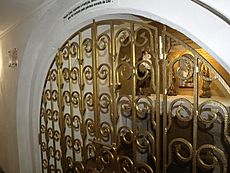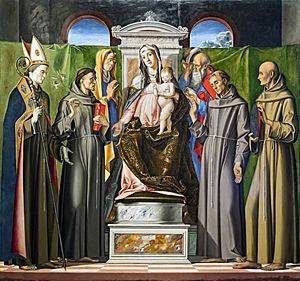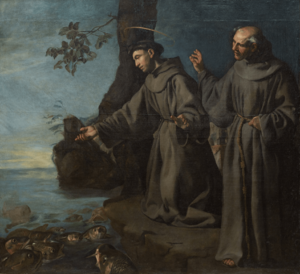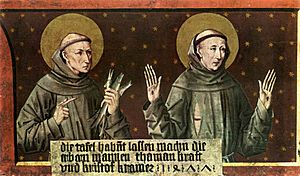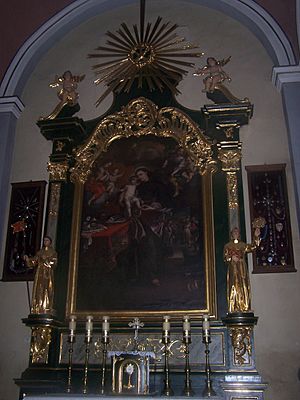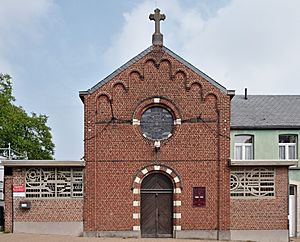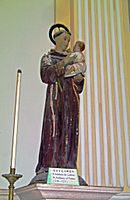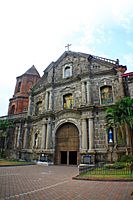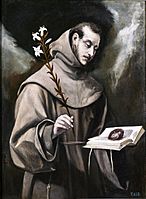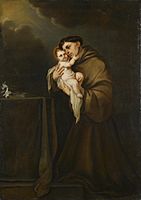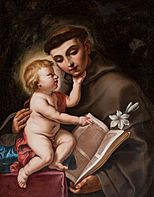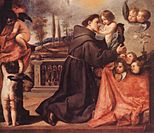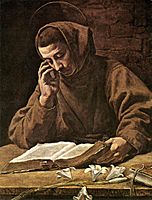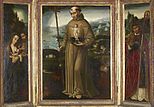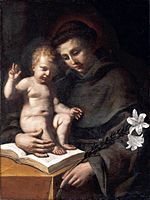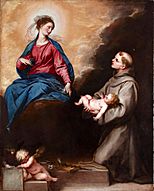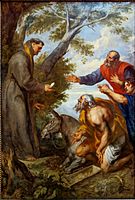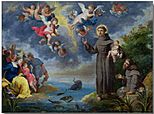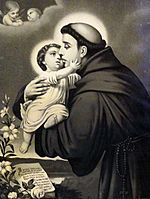Anthony of Padua facts for kids
Quick facts for kids SaintAnthony of Padua OFM |
|
|---|---|
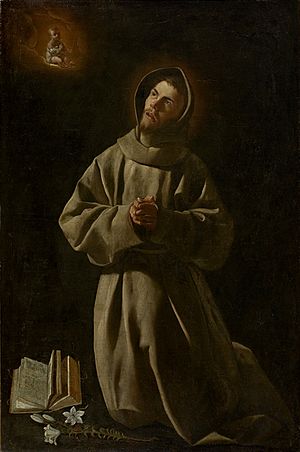
Anthony of Padua by Francisco de Zurbarán, 1627–1630
|
|
| Doctor of the Church | |
| Born | 15 August 1195 Lisbon, Portugal |
| Died | 13 June 1231 (aged 35) Padua, Italy |
| Venerated in | Roman Catholic Church Anglican Communion |
| Beatified | 30 May 1232 |
| Canonized | 30 May 1232, Spoleto, Italy by Pope Gregory IX |
| Major shrine | Basilica of Saint Anthony of Padua, Church of Saint Anthony of Lisbon |
| Feast | 13 June |
| Attributes | Fransciscan habit, lily, book, tonsure, holding the Infant Jesus, mule |
| Patronage | Custody of the Holy Land, miracles, travelers, finding lost items, pregnancy, harvests, animals, lost people, poverty, the sick, the disabled, the oppressed, the hungry, the elderly, faith in the Blessed Sacrament, sailors, fishermen, watermen, mail carriers, indigenous peoples of the Americas, Tigua, Padua, Lisbon, Portugal, Brazil, Pila, Laguna, Taytay, Rizal, Iriga, Camarines Sur, Camaligan, Camarines Sur, Tuburan, Cebu, Cusco, Peru |
Saint Anthony of Padua (born Fernando Martins de Bulhões; 15 August 1195 – 13 June 1231) was a Portuguese Catholic priest and friar of the Franciscan Order. He was born into a wealthy family in Lisbon, Portugal. He later died in Padua, Italy.
Anthony was known for his powerful speeches, deep knowledge of the Bible, and strong love for the poor and sick. He became a saint very quickly, less than a year after he died. In 1946, he was given the special title of Doctor of the Church by Pope Pius XII.
Contents
His Life Story
Early Years and Studies
Fernando Martins de Bulhões was born in Lisbon, Portugal. His family was wealthy and important. When he was 15, he joined a religious group called the Canons Regular of the Holy Cross of Coimbra at the Monastery of São Vicente de Fora near Lisbon.
In 1212, he moved to the Monastery of the Holy Cross in Coimbra, which was then the capital of Portugal. He wanted to study theology (the study of religious faith) and Latin without distractions.
Joining the Franciscans
After becoming a priest, Fernando was put in charge of welcoming guests at the monastery. While in Coimbra, he met some Franciscan friars. He was very impressed by their simple way of life, which focused on helping others and living like the early Christians. The Franciscan order had only been started 11 years before.
News came that five Franciscans had been killed in Morocco. They were the first members of their order to die for their faith. Inspired by their bravery, Fernando decided to leave his old order and join the Franciscans. He took the name Anthony, after the chapel where he joined.
Anthony then planned to travel to Morocco, but he became very sick. He had to sail back to Portugal to get better. However, his ship was blown off course and landed in Sicily, an island in Italy. From there, he traveled to Tuscany. Because he looked sickly, he was assigned to a quiet country hermitage (a place for religious retreat) near Forlì. He spent a lot of time there in prayer and study.
A Gift for Preaching
In 1222, at a special event in Forlì, there was a mix-up about who should give the sermon. No one was prepared, so the head of the hermitage asked Anthony to speak. Anthony was hesitant, but he agreed. His speech deeply impressed everyone. People were amazed by his clear voice, his deep knowledge of the Bible, and how well he spoke.
Anthony's talent for preaching soon caught the attention of Francis of Assisi, who founded the Franciscan order. Francis had been worried about too much study, fearing it might make friars forget their simple life. But in Anthony, he found someone who shared his vision and could also teach new friars. In 1224, Francis asked Anthony to be in charge of studies for the friars.
A famous story about Anthony involves a lost book of psalms. This book was very important to him because it had all his notes for teaching. A young friar who was leaving the order took the book with him. Books were very valuable back then, as they were copied by hand. Anthony prayed for the book to be found. The thief felt bad and not only returned the book but also came back to the order.
Anthony also taught at universities in France, but his preaching was his greatest gift. He became the leader of the Franciscan order in northern Italy and chose Padua as his home. In 1228, he met Pope Gregory IX, who called his preaching a "jewel case of the Bible."
Amazing Stories
Many stories are told about Saint Anthony's miracles.
One story says that in Rimini, some people refused to listen to Anthony's sermons. So, Anthony went to the seashore and began to preach to the water. A huge crowd of fish gathered before him! The people of the town came to see this amazing sight. Anthony then told them that the fish were more willing to listen than the people. This made the people finally listen to his message.
Another story from Toulouse tells of a man who challenged Anthony to prove that Jesus was truly present in the Eucharist (the holy bread used in church). The man brought a hungry mule and showed it fresh food in one hand and the holy bread in the other. The story says the mule ignored the food and bowed down before the holy bread.
There is also a story about Anthony dining with some people who disagreed with his teachings. They tried to poison his food. Anthony realized this and confronted them. They dared him to eat, quoting a Bible verse that said apostles would not be harmed by poison. Anthony blessed the food, ate it, and was perfectly fine, amazing his hosts.
His Death
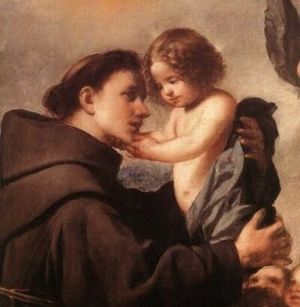
In 1231, Anthony became very sick. He went to a quiet woodland retreat with two other friars. He died on his way back to Padua on June 13, 1231, at the age of 35.
Anthony was buried in a small church. Because he became so famous, a large church called the Basilica of Saint Anthony of Padua was started in 1232 and finished in 1301. This church is often called "Il Santo" (The Saint) today.
Legends say that when Anthony died, children cried in the streets, and church bells rang by themselves. Another legend is about his tongue. When his body was moved 30 years after his death, it was said that his tongue looked fresh and shiny, as if he were still alive. People believed this showed his amazing gift for preaching.
Saint and Doctor of the Church
Pope Gregory IX made Anthony a saint on May 30, 1232, less than a year after he died. This was one of the fastest times for someone to become a saint in history!
Honored as a Patron Saint
Saint Anthony's fame spread widely, especially through Portuguese explorers and missionaries. He is known as one of the most celebrated followers of Francis of Assisi. He is the patron saint (a special protector) of Padua and many places in Portugal and other countries that were once part of the Portuguese Empire.
People around the world often ask for his help in finding lost items. He is believed to have helped many people find lost things, lost people, and even lost spiritual peace.
North America
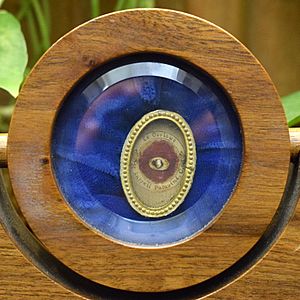
In 1692, Spanish missionaries found a Native American community along a river on Saint Anthony's feast day, June 13. They named the river after him, and later a mission was built nearby. This mission grew into the large U.S. city of San Antonio, Texas.
In New York City, the Shrine Church of St. Anthony in Greenwich Village celebrates his feast day with a week of services and a street fair. A traditional Italian procession carries a relic of the saint through the streets.
Every August, Boston's North End holds a big celebration for Saint Anthony. This "Feast of All Feasts" started in 1919 with Italian immigrants from Montefalcione, Italy.
The Sandia Pueblo and Santa Clara Pueblo in New Mexico celebrate Saint Anthony's feast day with traditional Native American dances.
In Beaumont, Texas, a church named after Saint Anthony was built in 1907. It later became a cathedral and then a minor basilica.
Saint Anthony also gives his name to Mission San Antonio de Padua in California, founded in 1771.
Brazil and Europe

In Portugal, Spain, and Brazil, Saint Anthony is seen as a saint who helps couples. His feast day, June 13, is a holiday in Lisbon, celebrated with parades and weddings. He is also celebrated in Brazil's Festa Junina.
In Brusciano, Italy, a yearly festival for Saint Anthony involves carrying tall towers called gigli through the streets. This tradition came to America, especially East Harlem in New York, where Italian immigrants continue the celebration.
In Albania, the St. Anthony Church, Laç was built in his honor. In Poland, he is the patron saint of Przeworsk.
Asia
Saint Anthony is honored in Uvari, India. A legend says that a Portuguese ship's crew was cured of a sickness through his help. The local church has an old wooden statue believed to be carved by one of the crew members.
In the Philippines, devotion to Saint Anthony began in 1581 in Pila, Laguna, where the first church dedicated to him was built. It is now a national shrine.
In Siolim, India, Saint Anthony is shown holding a snake on a stick. This comes from a story where a snake was stopping construction of a church. People prayed to Saint Anthony, and the next morning, the snake was found caught in the cord of his statue.
-
St. Anthony of Padua in St. Joseph's Church, Macao.
-
National Shrine of St. Anthony of Padua, Pila, Laguna, Philippines.
Africa
Antonianism was a religious movement in the Kingdom of Kongo (part of modern-day Africa) between 1704 and 1708. It was started by a young woman named Beatriz Kimpa Vita, who said she was guided by Saint Anthony of Padua. She was known for healing people.
In Art
Artists often show Saint Anthony in special ways to help people recognize him. He is often seen with a white lily stalk, which represents his purity. Sometimes, he is shown with a flaming heart, showing his strong faith.
He is also often shown with the mule from the story in Rimini, bowing down to the Eucharist. Many paintings show him meditating on an open book, where the Infant Jesus appears. Over time, the child became larger in paintings, and sometimes the book is not even there. He is often shown carrying the Infant Jesus and holding a cross.
- Anthony of Padua in Art
-
An early work by Raphael, 1503, at the Dulwich Picture Gallery, London, UK.
-
Baby Jesus with St. Anthony of Padua, Elisabetta Sirani, 1656, Bologna, Italy.
-
Anthony of Padua with the Infant Jesus by Antonio de Pereda.
-
Triptych of Saint Antonius by Ambrosius Benson.
-
Saint Anthony of Padua with the Infant Christ by Guercino, 1656, Bologna, Italy.
-
Vision of Saint Anthony, by Alonso Cano.
-
St. Antony with Christ Child, from Carinthia, in Austria.
-
Saint Anthony of Padua and the miracle of the mule, by Anthony van Dyck.
In Films
- The 1931 silent film Saint Anthony of Padua was directed by Giulio Antamoro.
- He was played in the 1949 Italian film Anthony of Padua by Aldo Fiorelli.
- Punitha Anthoniyar (Saint Anthony), a 1977 Indian Tamil-language film directed by Nanjil Durai.
- Umberto Marino's 2002 Sant'Antonio di Padova or Saint Anthony: The Miracle Worker of Padua is an Italian TV movie about the saint.
- Antonello Belluco's 2006 Antonio guerriero di Dio or Anthony, Warrior of God is a biopic about the saint.
- João Pedro Rodrigues directed the 2016 film The Ornithologist, a modern story inspired by the life of St. Anthony.
See also
 In Spanish: Antonio de Padua para niños
In Spanish: Antonio de Padua para niños
- Basilica of Saint Anthony of Padua
- Church of Saint Anthony of Lisbon
- Catholic Church in Italy
- List of Catholic saints



